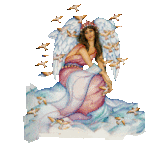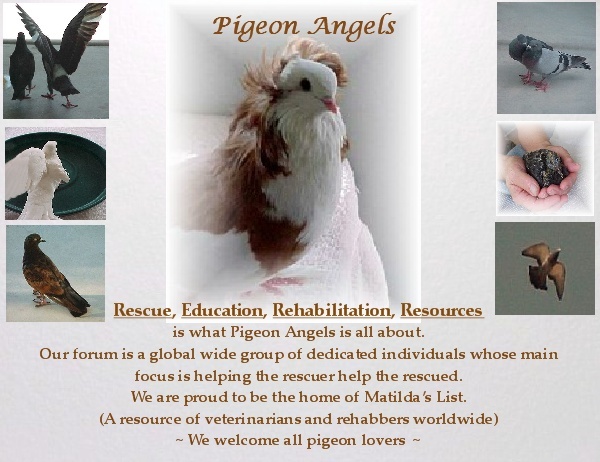Teresa
Administrative Member

Posts : 5381
Join date : 2009-07-23
Location : Portugal
 |  Subject: Overgrown beaks and nails Subject: Overgrown beaks and nails  Wed Jun 08, 2011 9:32 pm Wed Jun 08, 2011 9:32 pm | |
| Having a pigeon with an ever-growing upper beak and another with longer than usual nails has made me ask a lot of questions. Most people just keep trimming as needed, usually once a month. Care must be taken not to cause a bleed, so if in doubt it's best to get a vet to do it. Instructions on how to trim are here: http://www.mfgouldianfinches.com/Issues/Gouldian_Beak_And_Claws.htmlSome cases of overgrowth are genetic, and trimming is the only solution. But others aren't. One person's suggestion was to put the seed on an abrasive surface (like a paving stone with a higher 'frame' so the seed doesn't fall out) to encourage the bird to file his beak as he eats. There may be two problems related to this: one is that the way pigeons pick up seed is not conducive to filing the beak (unlike other species); the other is that a very long, curved beak may fracture with repeated impacts on a stone/cemented surface, so this should not be attempted instead of trimming, but only after, when the beak is shorter and less curved. But what if it is the result of disease or a defficiency of some kind? After a few searches, I found these articles. Please bear in mind they are for birds in general, and not specifically for pigeons.Source: http://www.mfgouldianfinches.com/Issues/Gouldian_Beak_And_Claws.html - Quote :
- There are many reasons a birds beak may become overgrown. The bird may not be the greatest at personal hygiene and does not wipe its beak on rough surfaces to prevent the overgrowth. It has been said that over medicating a bird will cause it's beak to grow too long.
And oddly enough, an overgrown beak can be a sign of calcium deficiency. Overly rich foods can cause beaks and nails to grow excessively long in a short period of time.
Overgrown claws can also be a symptom of over medicating or calcium deficiency, however many birds just aren't getting the right type of perch. With a variety of perch sizes and forms (cement, sand, rock, wood, etc.), your bird should be able to keep its nails trimmed on its own. Source: http://www.avianweb.com/beakdeformities.html - Quote :
- Overgrown maxillas and mandibles (upper / lower bill)
The maxilla (upper beak) tip is the most common site of overgrowth. Uneven beak wear is often noticeable, especially along the occlusal or biting surfaces of the upper and lower beaks, usually occurring on both surfaces.
An overgrown beak can be the result of health problems, including:
•Trauma to the beak
•Infections (common in finches)
•Liver disease - often the case with birds that have been on a seed-only diet for a long time resulting in a condition called "Hepatic Lipidosis" aka Fatty Liver Disease. This disease may result in soft areas around the beak and abnormal beak development, including overgrown beaks. Some birds also have overgrown nails / claws (that appear to grow faster than normal).
•Lack of light exposure
◦Vitamin D3 is crucial for overall health. Birds need exposure to UVA and UVB rays from direct sunlight (windows block necessary UV rays) or full-spectrum lighting to synthesize vitamin D necessary for bone and beak health. The indoor bird does not have the benefit of this reaction - deficiency may result in soft bones and a defective upper beak development
•Nutritional Imbalances
◦Vitamin A deficiency may result in abnormalities of kidneys, eyes and skeleton
◦Folic acid deficiency may result in bent tibiotarsus (long leg bone), syndactyly (fused toes), and beak malformations
◦Riboflavin (Vitamin B2) deficiency may result in altered limb and beak development
◦Niacin deficiency may result in bone and beak malformations
•Lack of minerals / natural grooming aids: Providing sufficient cuttlebone or mineral blocks in your pet's cage will help your pet groom his or her beak naturally, usually preventing it from overgrowing. However, there have been concerns about mercury contamination with cuttlebones, which should be kept in mind. Excellent "beak conditioners" are lava rocks that are either suspended on chains or can be attached to cage bars. Cement and sandy perches are also effective for beak wiping and for keeping the beak groomed and should be cleaned often to prevent bacterial infection. Pet stores sell a range of beak conditioning products. The above will help keep new growth under control, and will keep the beak healthy and in good form. It is also recommend to provide a variety of chew toys and natural bird-safe branches for your bird to chew on.
When a beak overgrows (usually the upper beak), regular beak trimming may be necessary - until the cause is resolved. Fatty Liver Disease seems to come up a lot, and can cause poor absorption of calcium, according to the next article. Source: http://www.holisticbirds.com/pages/fld0502.htm - Quote :
- Fatty Liver Disease is also called Hepatic Lipidosis (hepatic-liver; lipid-fat; osis-condition.) The Manual of Avian Practice by Rupley lists Fatty Liver as excessive fat deposited and stored in the liver. In a fatty liver, normal liver cells are replaced with fat. If this continues, the liver can no longer function properly. However the liver has been known to function with even 80% damage and no physical signs.
Confirmed diagnosis of liver disease requires the use of laboratory testing procedures.
Bile, produced by the liver, is necessary for fat digestion. It breaks fat into smaller globules, aids in the absorption of fat-soluble vitamins, converts carotene into vitamin A, and is involved in the absorption of calcium. | |
|
AZWhitefeather
Owner/Administrator

Posts : 10863
Join date : 2009-01-11
Location : Arizona Southwestern United States
 |  Subject: Re: Overgrown beaks and nails Subject: Re: Overgrown beaks and nails  Thu Jun 09, 2011 9:15 pm Thu Jun 09, 2011 9:15 pm | |
| Great links, Teresa.  Thank you for sharing them with us.  | |
|
Teresa
Administrative Member

Posts : 5381
Join date : 2009-07-23
Location : Portugal
 |  Subject: Re: Overgrown beaks and nails Subject: Re: Overgrown beaks and nails  Thu Jun 09, 2011 10:33 pm Thu Jun 09, 2011 10:33 pm | |
| There may not be a quick-fix solution for this problem in pigeons...  - Cynthia wrote:
- I checked "Fit to Win" by Dr Wim Peters (it is specifically about pigeons). He says:
Parrot beak occurs as a result of damage to the upper beak upsetting its growth pattern, which results in uncontrolled cell division and beak growth. The maxillae grow in a downward curve and the mandibles (lower beak) maintaining a close apposition with the maxillae, follow the direction of growth.
The damage arises from physical trauma or from infection, specially with the pox virus. Should eating become difficult, the beak must be trimmed at regular intervals as the condition is permanent. If eating is not affected it is best not to interfere. | |
|
AZWhitefeather
Owner/Administrator

Posts : 10863
Join date : 2009-01-11
Location : Arizona Southwestern United States
 |  Subject: Re: Overgrown beaks and nails Subject: Re: Overgrown beaks and nails  Sat Jun 11, 2011 11:43 pm Sat Jun 11, 2011 11:43 pm | |
| That's a very interesting piece, Teresa.  Thanks for posting it. | |
|
Sponsored content
 |  Subject: Re: Overgrown beaks and nails Subject: Re: Overgrown beaks and nails  | |
| |
|


